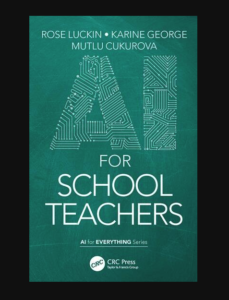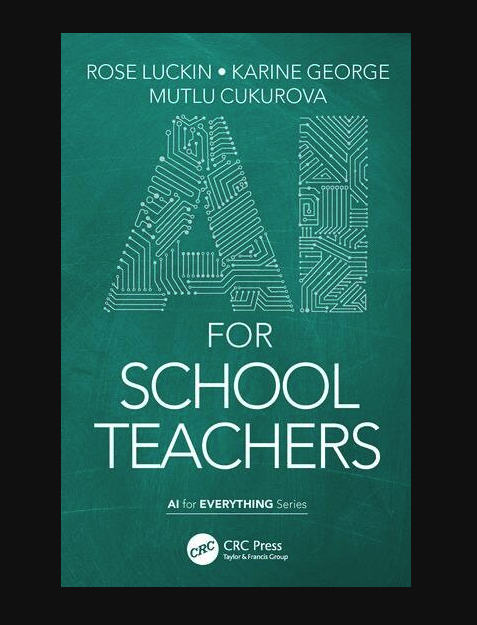
by Rose Luckin and Rowland Wells
This post was written by Professor Rose Luckin, Founder, and Rowland Wells, Director of Research Communication (non-academic) at EDUCATE Ventures Research. The purpose of the blog is to help open the door between the worlds of research and practice a bit wider so that we can see the differing perspectives and start a dialogue. We are always looking for more practitioners and researchers who want to join us in this work.
In the newly published ‘AI for School Teachers’, by Professors Rose Luckin, Mutlu Cukurova, and Headteacher Karine George, a blueprint for working with AI in schools is laid out in precise and practical detail. It explains how classroom teachers can hack the AI conversation using a holistic methodology applied to any number of challenges faced in educational settings.
Such challenges could be:
- Trying to recruit, train or retain the best staff
- Analysing attainment gaps
- Concerns about bullying
- Trying to address the gender gap in maths
- Understanding learning analytics
- Worries about pupil attendance
- Uncertainty as to whether marking and feedback engages students or actually helps them learn
The methodology described in the book is called the 7-Step AI Readiness Framework, and it is rooted in ethics, and designed to educate and enthuse leadership and colleagues about AI. The book supports this process of learning about AI through helping readers understand what it could reveal from the data they have at their disposal, and how AI would go about processing that data to produce useful outcomes.
The premise in the book is that by contextualising AI for a reader’s own experience, a better understanding of what AI can do and how it works at a non-technical level can be achieved. There is some terminology employed, such as ‘Unsupervised Machine Learning’, but the book uses everyday analogies, like cooking, to explain the processing of data that Unsupervised Machine Learning can achieve, and why this could lead to useful ways AI can help schools solve some of their toughest challenges.
It is recognised in the book that classroom teachers are frequently time-poor and operating at capacity. The authors remain convinced, however, that those educators working in schools, colleges, and universities are the ones best placed to conduct and lead on the process. The authors aim to show teachers and their leaders how AI can help them tackle some of the most pressing educational challenges they face and in so doing they hope that this will help teachers justify to themselves and their managers that spending time on getting to grips with AI is essential; likewise, that mangers and leaders will understand why they and their team must have time to get AI Ready.
The consequences of not getting AI Ready are that challenges that could be addressed more effectively with AI continue to remain unsolved, and that meagre educational budgets are wasted on AI products and services that are not the right ones for the purchaser’s needs. The only winners in this situation are the companies making the money from the AI!
AI for School Teachers is there to help ensure teachers and learners are the winners when it comes to the benefits of AI, because there really are some significant benefits to be reaped.
None of the above can be achieved without the support of the school’s headteacher or administrative infrastructure. The case must be made to colleagues and leadership that those in charge of timetabling create capacity for the tackling of challenges and learning about AI in the school, which is why the first step in the 7-Step AI Readiness Framework is about educating, enthusing, and exciting the people you work with!
7-Step AI Readiness Framework
STEP 1 what is AI and how can you and your colleagues develop an AI mindset?
Educate, Enthuse, Excite.
The Key learning objectives of this step include understanding why data is so important to machine learning AI along with the basic implications of AI for their role/position/life; and knowing that there are a range of activities that AI can achieve, such as speech recognition and that it can enable the creation of autonomous systems and what this means.
STEP 2 what challenges do you currently face in your work role or in your life? How can you decide which challenge to focus on when it comes to AI readiness?
Tailor and Hone.
The Key learning objectives of this step include understanding the criteria that can be used to decide which challenges are best suited to AI tools and methods and the basics about the types of task that AI is particularly good at completing and the types of task that are much better completed by humans (this is the foundation for later learning); and knowing that they already come into contact with many different types of data every day that can be collected, analysed and learnt from, using AI.
STEP 3 what is data and how its value can be identified – what data you can access to and how it can be collated?
Identify and Collate data.
The Key learning objectives of this step include understanding the sorts of sources of data that are relevant to their work/life and the differences between different data sources and the ethical implications that are relevant to collecting and collating data of the sort that AI uses; and knowing that data exists about a range of factors within their work or their individual learning including: the physical environment, the virtual environment, the curriculum, the pedagogy, the use of resources and the connections between these resources as well as between the resources and the people who use them
STEP 4 what new data do you need to address the challenge you identified in STEP 2 and what new data is available and how can you collect it?
Collect data
The Key learning objectives of this step include understanding how to collect some new data that is relevant to the challenge they have selected and that fills an important data gap and the potential biases that can occur in data collection and use and therefore in AI systems; and knowing that different data collection methods are suitable for different data sources and that some data is more credible than other data. If an AI system has been built with data that lacks credibility it will be at best ineffective and in the worst case downright dangerous.
STEP 5 – what are the AI techniques that it is appropriate to use with educational or training data?
Apply analysis and AI techniques to your data.
The Key learning objectives of this step include understanding what can be achieved by using AI as part of the data analysis process along with the ethical implications that are relevant to selecting and applying AI to data; and knowing that there are a range of AI techniques that can be applied, what they do and when to use them
STEP 6 – what is the data that has been analysed in STEP 5 telling them about their challenge?
Learn
The Key learning objectives of this step include understanding the of what AI can help them to learn from the data they have identified about their challenge; and knowing that there are no set answers to exactly what can be learnt from applying AI to data and that interpretation is important
STEP 7 How can ETHICS be embedded into the way we use AI? Am I/my organisation now AI ready – how do I know?
Iterate
The Key learning objectives of this step include understanding what evidence there is that they/their organisation is/are now AI ready and the ethical implications that are relevant to all steps in the AI readiness programme and how AI can be developed and applied; and knowing the criteria for making decisions about whether or not a further iteration through the AI readiness programme is needed
The above was a very brief summary of the 7-step AI Readiness Framework and how it could help tackle some of the challenges in your school. To find out more about how you can benefit from examining your institution through a ‘data and AI lens’, and leveraging the transformational power of AI to tackle your challenges, order your copy of AI for School Teachers, and take our newly launched AI Readiness Diagnostic, a set of quick and simple questions tied to the 7 steps of the AI Readiness Framework. With each of your answers, the diagnostic tool provides you with a visual map of your current expertise, and offers a wealth of recommendations and reading material appropriate to your stage of AI innovation, even if you’re just taking your first step on an AI journey.
Educator CIRCLS posts are licensed under a Creative Commons Attribution 4.0 International License. If you use content from this site, please cite the post and consider adding: “Used under a Creative Commons Attribution 4.0 International License (http://creativecommons.org/licenses/by/4.0/).”
Suggested citation format: [Authors] ([Year]). [Title]. Educator CIRCLS Blog. Retrieved from [URL]

